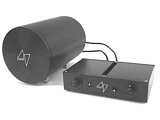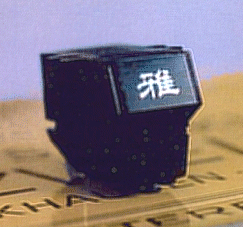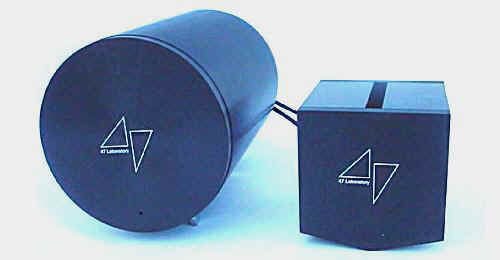The 47 Laboratory Phono Playback System
| The 47 Laboratory Phono Playback System |
|
Paul Szabady |
|
16 March 2001 |
| 4712 PHONOCUBE MC Cartridge Equalizer | $2,100 |
| 4700 Power Humpty power supply | $1,800 |
| System Price | $3,900 |
| Miyabi 47 moving coil phono cartridge | $3,990 |
| 4706 GAINCARD power amplifier | $1,500 |
| 4700 Power Humpty power supply | $1,800 |
| System Price | $3,300 |
| Total System Price | $11,190 |
Distributed by
Sakura Systems
2 Rocky Mt. Rd.
Jefferson MA 01522
Tel: (508) 829-3426
e-mail: sakurastms@aol.com
Website: www.sakurasystems.com
Only The Most Simple Can Accommodate the Most Complex
I must admit to a deep sympathy with maverick designs that challenge orthodox ways of doing things. Couple that unconventional design with an aesthetic genuinely rooted in Zen philosophy and my attention is guaranteed. 47 Laboratory is just such a company; their design credo aligns them with a long Japanese tradition that also inspired the Bauhaus, Frank Lloyd Wright, many 20th century artists, even penetrating popular US culture – “Less is More” and “K.I.S.S.” (Keep It Simple, Stupid!) – derive from that same inspiration.
Anyone familiar with Haiku poetry, Sumi-e landscape painting, the Zen Garden, or Bonsai will immediately recognize the underlying principle, a simplicity and solidity of form that seems almost artless, evoking the impression that the object occurred spontaneously and naturally, manifesting both capital and small “r” reality. (For Zen, the Ultimate Reality and common reality are one and the same.)
Applied to 47 Laboratory’s products, this philosophy of simplicity manifests itself in very compact, almost miniature design, the shortest possible circuit paths, the minimum number of the highest quality parts, and an over-arching singularity and integration of design criteria. Dual-mono construction and a resonance-controlled chassis are further aspects of the integrated approach to ensure maximum information transfer. In this sense it shares some common principles with the SET tube school, the major difference being that 47 Lab’s products are solid-state.

Maverick the designs are, and as such, require readjusting habits acquired from conventional components. The Phonocube offers no input impedance, but amplifies the current of the MC rather than its voltage. Thus one needs to rethink one’s cartridge loading assumptions and apply a different formula in ascertaining correct loading. The Phonocube runs directly into the Gaincard power amp, which also offers volume control. (It can also be used with a conventional line stage preamplifier.) The power supplies are long cylinders (8 inches long with a 5-inch diameter) that rest on two small stainless steel devices that roughly resemble miniature hourglasses. The designs utilize op-amps. The speaker connectors will not allow the use of ocean-liner docking lines. The Gaincard amp produces 25 watts per channel. The Miyabi 47 cartridge has a flip-down stylus guard, a short cantilever and uses alnico magnets.
Why Do We Even Call Them Audio “Systems”?
It’s been a long accepted dogma that separate components are thepath to successful high fidelity. One can mix and match components from different manufacturers to theoretically produce the ideal sound for one’s needs and budget. But it is equally true that many real-world systems are anything but, often being a hodge-podge of components fighting each other, nullifying and compromising each other’s strengths, or just generally shooting each other in the foot. Thus there is much to commend a true system approach in which all the components are made by one manufacturer and thus share one overarching design concept and a consistent sound. Listening to a complete Linn or Rega system, for example, allows one to experience the design’s intention. To fully understand the 47 Laboratory approach, I did most of my auditioning to their products as a complete phono playback system.
 The Miyabi 47 moving coil cartridge was designed and manufactured by Miyabi to implement 47 Labs’ philosophy. Its internal impedance is 2 ohms, allowing sufficient output from the current-amplifying Phonocube to drive the Gaincard directly. No active line stage preamplification is necessary. Utilizing alnico magnets (which some retro-enthusiasts imbue with an almost mystical quality); a short and stiff aluminum cantilever with a line-contact stylus; and a generating system that is physically protected by a woven, fabric-like material, the cartridge evokes memories of the vintage Supex in appearance. Like many older MC cartridges, it also dumps a lot of vibrational energy into the arm and record – needle-talk is louder than some conventional designs.
The Miyabi 47 moving coil cartridge was designed and manufactured by Miyabi to implement 47 Labs’ philosophy. Its internal impedance is 2 ohms, allowing sufficient output from the current-amplifying Phonocube to drive the Gaincard directly. No active line stage preamplification is necessary. Utilizing alnico magnets (which some retro-enthusiasts imbue with an almost mystical quality); a short and stiff aluminum cantilever with a line-contact stylus; and a generating system that is physically protected by a woven, fabric-like material, the cartridge evokes memories of the vintage Supex in appearance. Like many older MC cartridges, it also dumps a lot of vibrational energy into the arm and record – needle-talk is louder than some conventional designs.
Designed for maximum information transfer, the design requires careful set-up in arm height to avoid the generator-protecting fabric from fouling the record. As such it deviates from standard procedures and rules-of-thumb in setting the vertical tracking angle (VTA). One raises the arm just enough so that the woven material does not contact the record. Unlike most cartridges, Miyabi 47 is optimized for what is commonly called positive VTA, i.e., the front of arm is lower than the back. Pay insufficient attention to this adjustment and you’ll be muttering about a $4000 needle. Take the time and get it right and you’ll wonder how 47 Labs achieved this level of realism so inexpensively.
A permanently attached flip-down, old-fashioned stylus guard quells the anxiety of accidentally lunching a $3990 cartridge. With tracking force set at 2 grams and arm height optimized, tracking was secure and precise.
Note: The alnico magnets will attract mounting tools and nuts in a flash if they get too near the cartridge, so extra care is required when bolting things up.

Since the output of the Phonocube drives the Gaincard amplifier directly, Sakura Systems recommends using minimal lengths of interconnects and speaker cables. Being a true dual-mono design, the Gaincard includes 2 muting switches, 2 ground screws, and dual volume controls. The latter are ratchet types and somewhat coarse in gradation, but I never found myself wanting a volume level in between the click-stops.
My reference Sound Lab DynaStat loudspeakers, electrostatic/dynamic hybrids, are an easy 8-ohm load and 88dB efficient. I had no concerns that the Gaincard’s 25 watt-per-channel output would be insufficient to drive them, having had excellent results with 30 watt-per-channel tube amplifiers. Though an electrostatic speaker’s capacitive load can produce unpredictable sonic results from an amplifier, I had no problem driving the DynaStats to my normal 90dB volume limit. 47 Labs also makes a 50 watt-per-channel version of the Gaincard to for less efficient speakers. I also briefly ran the Gaincard into 4- and 8-ohm dynamic designs of 87 dB sensitivity (Infinity and Spendor speakers).
WHY: What, Where, How…
I often use a simple, quasi-journalistic scheme of “What, Where, How, and Why,” to aid judging audio gear. I want to know “WHAT” the instrument is, “WHERE” it is located within the sound field, “HOW” it is being played, and ultimately, the musical meaning –the “WHY” of it all.
I’ve never heard a group of components as sensitive to the sonic effects of different interconnects, speaker cable, and tonearm set-up as the 47 Labs. I hauled out the usual array of interconnects and speaker cables, and since Sakura Systems sells a cabling kit that utilizes a solid-core design, I used Analysis Plus Oval 9 interconnects with XLO speaker wire for most of my critical listening.
To my chagrin, I realized that setting the arm height once was not enough. Small changes in record thickness necessitated resetting the arm to achieve optimum performance. Being just a tiny bit off robbed the sound of dynamics, muddied the bass, and either rolled off or disassociated the highs from the context of the rest of the frequencies. To be blunt, resetting the arm height (VTA) for each record is a royal pain in the ass and I have assiduously tried to avoid it during my LP-playing life. To make LP playback less complicated, I set the arm height to suit the average record thickness of my LP collection and I fortunately had the Ringmat Record Support System to save the day. Consisting of a Ringmat, an anti-static mat, a record damper, a platter damper and various plastic platter-sized shims of various thicknesses, this clever system allows tuning tonearm height to the requisite optimum by adding or removing the plastic shims. While not exactly a piece of cake, it is much easier to use than changing the VTA for each record. It’s simple, consistent, and repeatable.
My overwhelming first impression of the 47 Lab phono system is that the quality of the tonality and dynamics of instruments is absolutely first rate. Harmonics are rich and full, tonal colors are vivid, and the timbre is coherent and extremely life-like. If the mantra for the SET school is “emotion,” then the 47 Lab phono systems’ is “Tonality, Tonality, Tonality.” The pure sensual beauty of the sound of a violin, a cello, or a double bass is so exquisitely rendered that one starts comparing their sound to live rather than to that of canned music. Aiding this revelatory naturalness is the exceptional dynamic capability and power in the mid and low bass – areas where most reproduced music is quite anemic compared to the live performance. Percussive bass can be positively concussive when called for, and yet is still full, rich, and agile. Ron Carter’s piccolo bass was unambiguously distinguishable from Buster Williams’ double bass on the Ron Carter Quartet recordings – a doubly impressive achievement since the mix places the two instruments in virtually the same central acoustic space. Those repelled by the anorexic tonality of some high-end designs will love this gear. Goodbye Ally McBeal, hello Sophia Loren!
Reproduction of the recorded acoustic and general stereo effects varies with the quality of the recording, revealing both processed, multi-miked studio jobs, and more organic attempts to recreate the live concert experience. Music takes place in a much larger area than the physical boundaries of the speakers, and while this liberation from physical constraints may nip incipient claustrophobia and induce ecstasy for imaging freaks, I don’t hold this intriguing and welcome effect to be an absolute necessity for audio enjoyment. It is, however, an excellent indication of stereo separation between channels – one of the benefits of dual-mono design. The soundstage can be truly breathtaking in its width and depth but presents images that are akin to a slightly distant seating perspective in a classical concert hall. Instrumental separation and focus does not mimic front row center. Instrumental sound and acoustic are one, coherent and complete. Instrumental size is very convincing, especially on panel speakers. Did you know that Miles Davis was shorter than John Coltrane? You’ll know it with this system. While quality of pressings and wear-&-tear on records is audible, it is never unduly spotlighted. Surface noise and pops/ticks are subdued and isolated, lying on an imaginary invisible plane at the speakers. The system extracts the maximum tonal pleasure from the recording. This is to be applauded. What’s the point of a hyper-analytical etched system that does nothing but tell you how bad every recording and pressing is?
Combo jazz, rock and roll, and smaller ensemble classical chamber music are served particularly well. Musically relevant detail is naturally presented with no exaggeration of extra-musical artifacts. Identifying the style and sonic signature of individual artists is a snap. Ever been confused as to who’s Coltrane and who’s Cannonball Adderly on “Kind of Blue”? Or which guitar is Dickie Betts’ and which is Duane Allman’s? Goodbye confusion! Vocals and the articulation of lyrics are particularly wonderful. It deeply annoys me when hi-fi gear slurs and blurs lyrics. This is not a problem with the 47 Lab system as even notorious, buried-in-the-mix, mumbling vocalists are easily understood.
In three extremely important areas for me, the 47 Labs system is among the best I’ve ever heard: reproducing the violin, the piano, and in the articulation of lyrics. I despair when these things aren’t done right, as listening fatigue quickly sets in and the illusion of music is easily punctured. Screw up the violin, the voice, and the piano and you’ve pretty much eliminated the entire classical corpus of music.
Although I find some other products to be more explicit in rendering the artistic meaning of a performance, the 47 Lab system does fairly well with the HOW: tension and release, call and response, subtle dynamic shadings and nuances of note articulation. Rhythmic coherence is somewhat variable though. Gentle swinging rhythms are better rendered than complex driven and polyrhythmic meters. Points of arrival, phrasing, and the general punctuation of series of notes are good but not exceptional, even with my gaggle of rhythm-master turntables. Extreme high-frequency response, while integrated into the sonic fabric, does not produce the sense of stratospheric overtones and sometimes softens the bell-like clarity of triangles and harps in orchestral music and can dull the rasp of brass. This effect seems likely to be partly the sonic signature of the Miyabi 47 cartridge (or perhaps its sensitivity to slight VTA errors). Other cartridges I ran through the Phonocube did not show the effect quite as strongly. Those who find the rising high-frequency response of many moving coil cartridges annoying and unnatural need have no worries about the Miyabi 47.
And yes, I did listen to each 47 Laboratory component in other equipment contexts. While the basic abilities of each component were still identifiable, the total effect was somewhat diminished. While using the Phonocube as a conventional phono stage and running it through an active line preamp might lessen concerns of adequate gain, the sonic contribution of the preamp will complicate and distort the picture to some extent. Running the Gaincard amp with an active preamp presented no problems, nor did the Miyabi 47 loaded into a conventional phono stage (provided that the 0.3 mV output can be accommodated). The complete phono system, however, was never matched by any other combination of components. This is definitely a case of system design working harmoniously together.
There has been an ongoing alternative to the hyper-detailed, etched, and clinical reproduction of many high-end products. Its most vocal manifestation has been the rise of the low-powered, single-ended triode tube movement. Significantly, this movement originated in Japan. Valuing emotion, tonality, and an organic presentation of the music, the movement questions the musical value of highly analytic systems that tell you everything about a recording except what the music means. The sterility of much CD playback was perhaps an impetus for this trend. Junji Kimura founded 47 Laboratory with the original specific purpose of trying to get CD playback to exhibit the naturalness that the best analogue takes as a given. Interestingly, Kimura’s designs have found high favor in the SET world, doubly important considering that solid-state designs are akin to heresy in this tube-oriented world.
While I find the 47 Lab’s reproduction of the WHAT to be of reference quality and the WHERE to be consistently engaging, I yearned for a bit more articulation of the HOW. This was particularly true for me in very rhythmically complex types of music but also held true for basic musical dialogue: it was almost as if the system was limiting musical speech to commas and periods. I yearned for a closer rendering, a more complexly punctuated view of the music. Thus the WHY of the performance fell somewhat short of the best I have heard. My wife however, who holds a Music degree in Piano Performance, found no problem with the punctuation and rhythmic abilities of the 47 Lab phono system. Perhaps listeners like me, who do not play an instrument, need more articulation and explicitness than those who, in a sense, hear the music from the inside.
Since 47 Lab does not make a loudspeaker, turntable, and tone arm, grasping Kimura’s total concept of what audio should sound like is somewhat incomplete. I, for one, would be extremely interested in further 47 Lab products that would compose a complete system.
I finished my listening to the 47 Laboratory phono system on Mardi Gras and sadly shipped it back to Sakura Systems on Ash Wednesday. After becoming acquainted with its riotous, lush and rich tonal balance, life without it is like the gray sullen season of Lent. If the rich pleasures of Fat Tuesday appeal more to you than the hair-shirt austerities of dim-gray self-denial, the 47 Lab system is for you.
![]()
Don’t forget to bookmark us! (CTRL-SHFT-D)
Stereo Times Masthead
Publisher/Founder
Clement Perry
Editor
Dave Thomas
Senior Editors
Frank Alles, Mike Girardi, Russell Lichter, Terry London, Moreno Mitchell, Paul Szabady, Bill Wells, Mike Wright, and Stephen Yan,
Current Contributors
David Abramson, Tim Barrall, Dave Allison, Ron Cook, Lewis Dardick, John Hoffman, Dan Secula, Don Shaulis, Greg Simmons, Eric Teh, Greg Voth, Richard Willie, Ed Van Winkle, Rob Dockery, Richard Doran, and Daveed Turek
Site Management Clement Perry
Ad Designer: Martin Perry






Be the first to comment on: The 47 Laboratory Phono Playback System